
How to Use 0V7670 Camera Module: Examples, Pinouts, and Specs
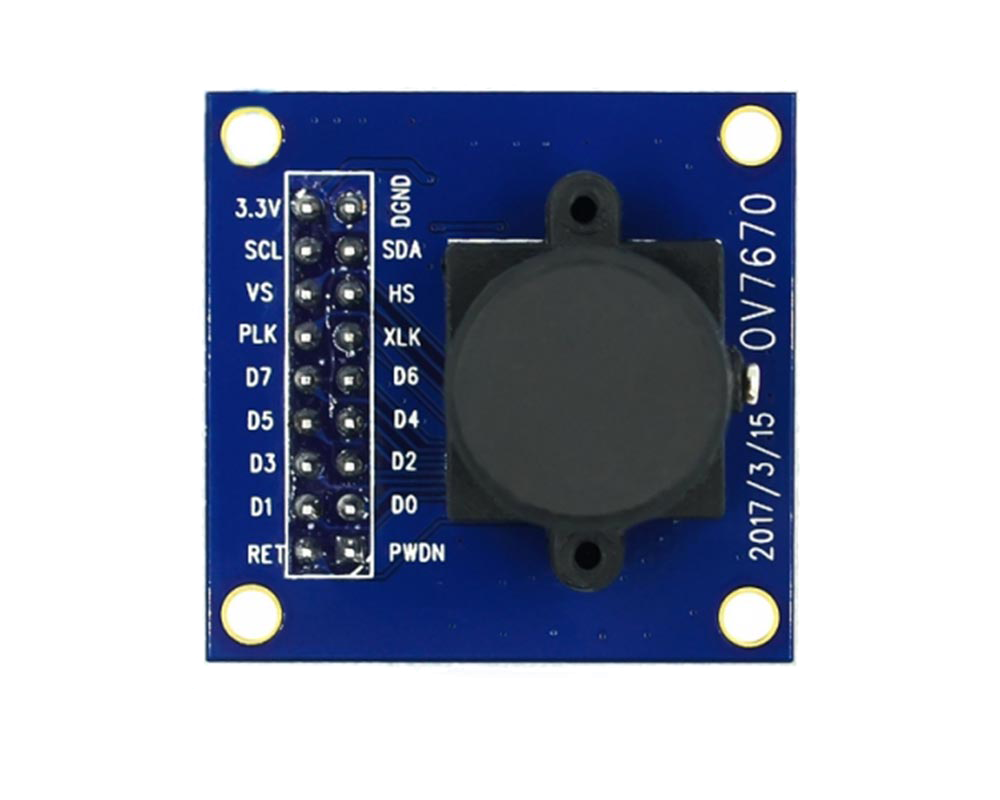
 Design with 0V7670 Camera Module in Cirkit Designer
Design with 0V7670 Camera Module in Cirkit DesignerOV7670 Camera Module Documentation
1. Introduction
The OV7670 Camera Module is a compact and cost-effective camera module designed for embedded systems and robotics applications. It features a VGA resolution (640x480 pixels) CMOS image sensor capable of capturing still images and video. The module is widely used in projects requiring image processing, such as object detection, facial recognition, and video streaming. Its small size and simple interface make it an excellent choice for integration with microcontrollers like the Arduino UNO.
Common Applications:
- Robotics: Object tracking, obstacle detection, and navigation.
- Embedded Systems: Image capture and processing for IoT devices.
- Surveillance: Low-cost video monitoring systems.
- DIY Projects: Home automation, motion detection, and facial recognition.
2. Technical Specifications
The following table outlines the key technical details of the OV7670 Camera Module:
| Parameter | Specification |
|---|---|
| Image Sensor | CMOS VGA (640x480 pixels) |
| Resolution | VGA, CIF, QCIF, and more |
| Pixel Size | 3.6 µm x 3.6 µm |
| Frame Rate | Up to 30 fps (frames per second) |
| Operating Voltage | 3.3V (logic level) |
| Power Consumption | ~60mW |
| Communication Interface | SCCB (Serial Camera Control Bus, similar to I2C) |
| Output Format | YUV, RGB, or RAW |
| Lens | Fixed focus |
| Operating Temperature | -30°C to 70°C |
Pin Configuration and Descriptions
The OV7670 Camera Module has a 10-pin interface. The pinout and descriptions are as follows:
| Pin | Name | Description |
|---|---|---|
| 1 | GND | Ground connection |
| 2 | VCC | Power supply (3.3V) |
| 3 | SCL | Serial Clock Line for SCCB (I2C-like interface) |
| 4 | SDA | Serial Data Line for SCCB (I2C-like interface) |
| 5 | VSYNC | Vertical synchronization signal (indicates the start of a new frame) |
| 6 | HREF | Horizontal reference signal (indicates valid pixel data in a row) |
| 7 | PCLK | Pixel clock (used to synchronize pixel data output) |
| 8 | XCLK | External clock input (typically 24 MHz) |
| 9 | D0-D7 | Data pins (8-bit parallel data output) |
| 10 | RESET | Active-low reset pin (optional, can be tied to VCC if not used) |
3. Usage Instructions
Connecting the OV7670 to an Arduino UNO
The OV7670 Camera Module can be connected to an Arduino UNO for basic image capture and processing. Below is a typical wiring configuration:
| OV7670 Pin | Arduino Pin | Description |
|---|---|---|
| GND | GND | Ground connection |
| VCC | 3.3V | Power supply |
| SCL | A5 | I2C Clock Line |
| SDA | A4 | I2C Data Line |
| VSYNC | Digital Pin 2 | Vertical sync signal |
| HREF | Digital Pin 3 | Horizontal reference signal |
| PCLK | Digital Pin 4 | Pixel clock |
| XCLK | Digital Pin 9 | External clock (via PWM output) |
| D0-D7 | Digital Pins 5-12 | 8-bit parallel data output |
| RESET | 3.3V (optional) | Reset pin (can be tied to VCC) |
Sample Code for Arduino UNO
The following code demonstrates how to initialize the OV7670 Camera Module and capture basic data. Note that the Arduino UNO has limited memory, so advanced image processing may require a more powerful microcontroller.
#include <Wire.h> // Include the Wire library for I2C communication
// OV7670 SCCB (I2C-like) address
#define OV7670_ADDRESS 0x42
// Function to write a register value to the OV7670
void writeRegister(uint8_t reg, uint8_t value) {
Wire.beginTransmission(OV7670_ADDRESS >> 1); // Start communication
Wire.write(reg); // Send register address
Wire.write(value); // Send value to write
Wire.endTransmission(); // End communication
}
void setup() {
Wire.begin(); // Initialize I2C communication
Serial.begin(9600); // Initialize serial communication for debugging
// Initialize the OV7670
writeRegister(0x12, 0x80); // Reset the camera module
delay(100); // Wait for reset to complete
// Set up basic configuration
writeRegister(0x12, 0x14); // Set output format to RGB
writeRegister(0x11, 0x01); // Set clock prescaler for frame rate
writeRegister(0x0C, 0x04); // Enable scaling
Serial.println("OV7670 initialized successfully!");
}
void loop() {
// OV7670 data capture logic can be implemented here
// For example, read pixel data from D0-D7 and process it
}
Important Considerations:
- Clock Signal: The OV7670 requires an external clock signal (XCLK). Use a PWM pin on the Arduino to generate a 24 MHz clock signal.
- Memory Limitations: The Arduino UNO has limited SRAM, which may not be sufficient for storing full VGA images. Consider using a microcontroller with more memory for advanced applications.
- Voltage Levels: The OV7670 operates at 3.3V logic levels. Use level shifters if interfacing with a 5V microcontroller.
4. Troubleshooting and FAQs
Common Issues and Solutions
| Issue | Possible Cause | Solution |
|---|---|---|
| No output from the camera | Incorrect wiring or power supply | Double-check connections and ensure 3.3V power is supplied to the module. |
| Distorted or noisy image | Incorrect clock signal or configuration | Verify the XCLK signal and ensure proper register configuration. |
| Arduino hangs during initialization | SCCB communication failure | Check I2C connections (SCL and SDA) and ensure pull-up resistors are present. |
| Image data is incomplete or corrupted | Insufficient memory on the microcontroller | Use a microcontroller with more SRAM or reduce image resolution. |
Frequently Asked Questions (FAQs)
Can the OV7670 capture video?
- Yes, the OV7670 can capture video at up to 30 fps, but real-time video processing may require a more powerful microcontroller than the Arduino UNO.
What is the maximum resolution supported?
- The OV7670 supports a maximum resolution of 640x480 pixels (VGA).
Do I need external components to use the OV7670?
- You may need pull-up resistors for the I2C lines and a crystal oscillator for the XCLK signal if your microcontroller cannot generate it.
Can I use the OV7670 with a 5V microcontroller?
- Yes, but you must use level shifters to convert the 5V logic levels to 3.3V.
This documentation provides a comprehensive guide to using the OV7670 Camera Module. For advanced applications, consider exploring additional libraries and tools for image processing.
Explore Projects Built with 0V7670 Camera Module
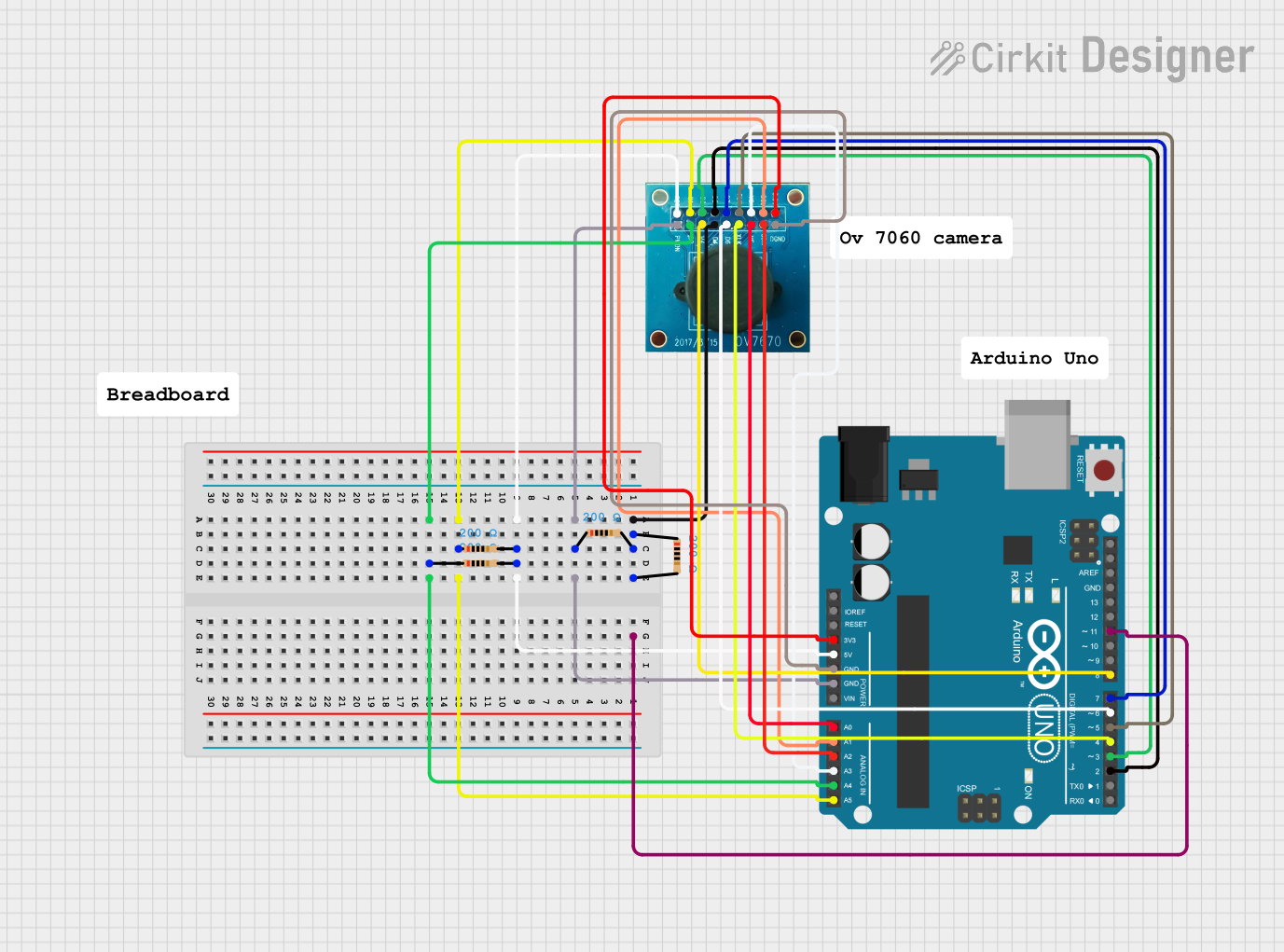
 Open Project in Cirkit Designer
Open Project in Cirkit Designer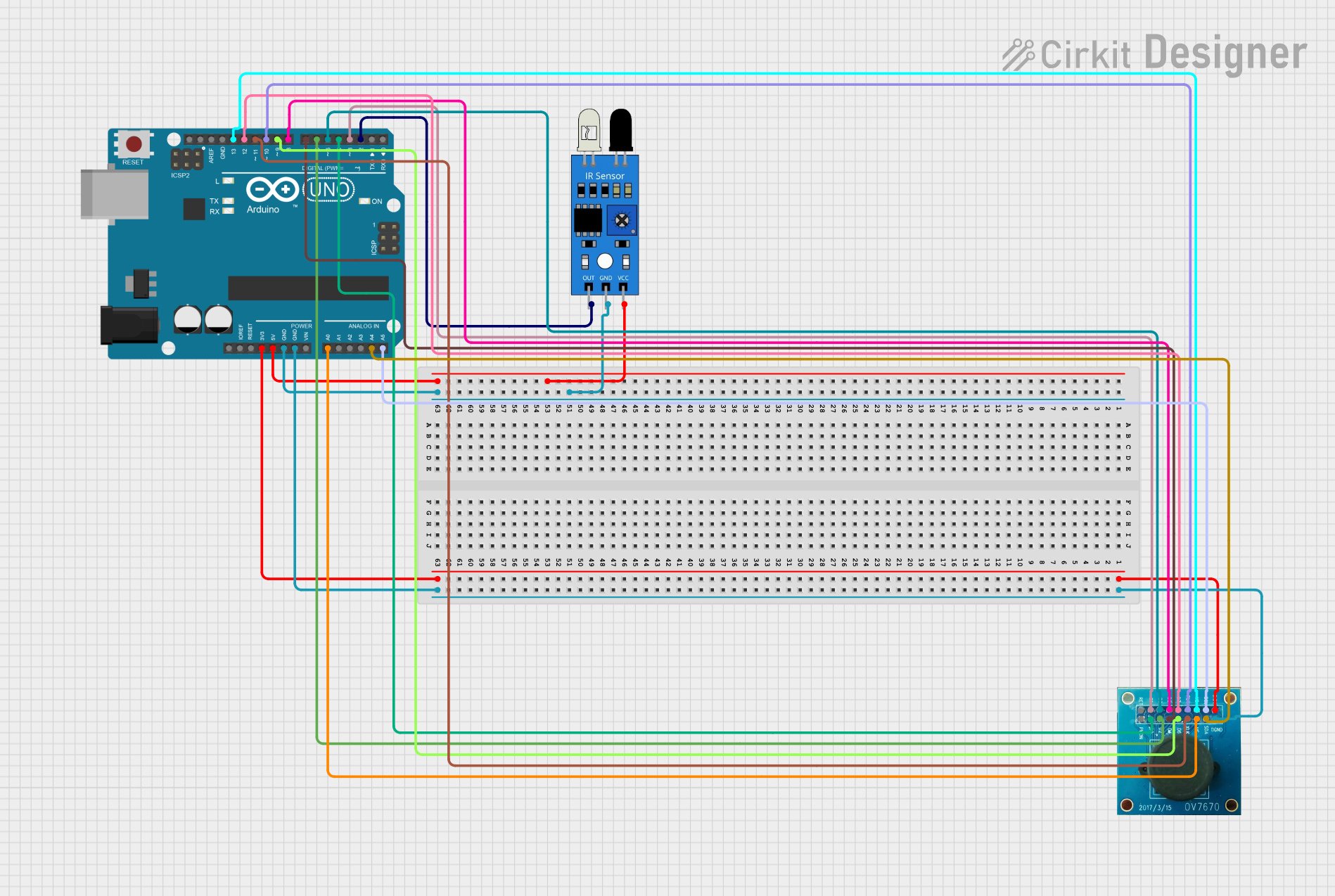
 Open Project in Cirkit Designer
Open Project in Cirkit Designer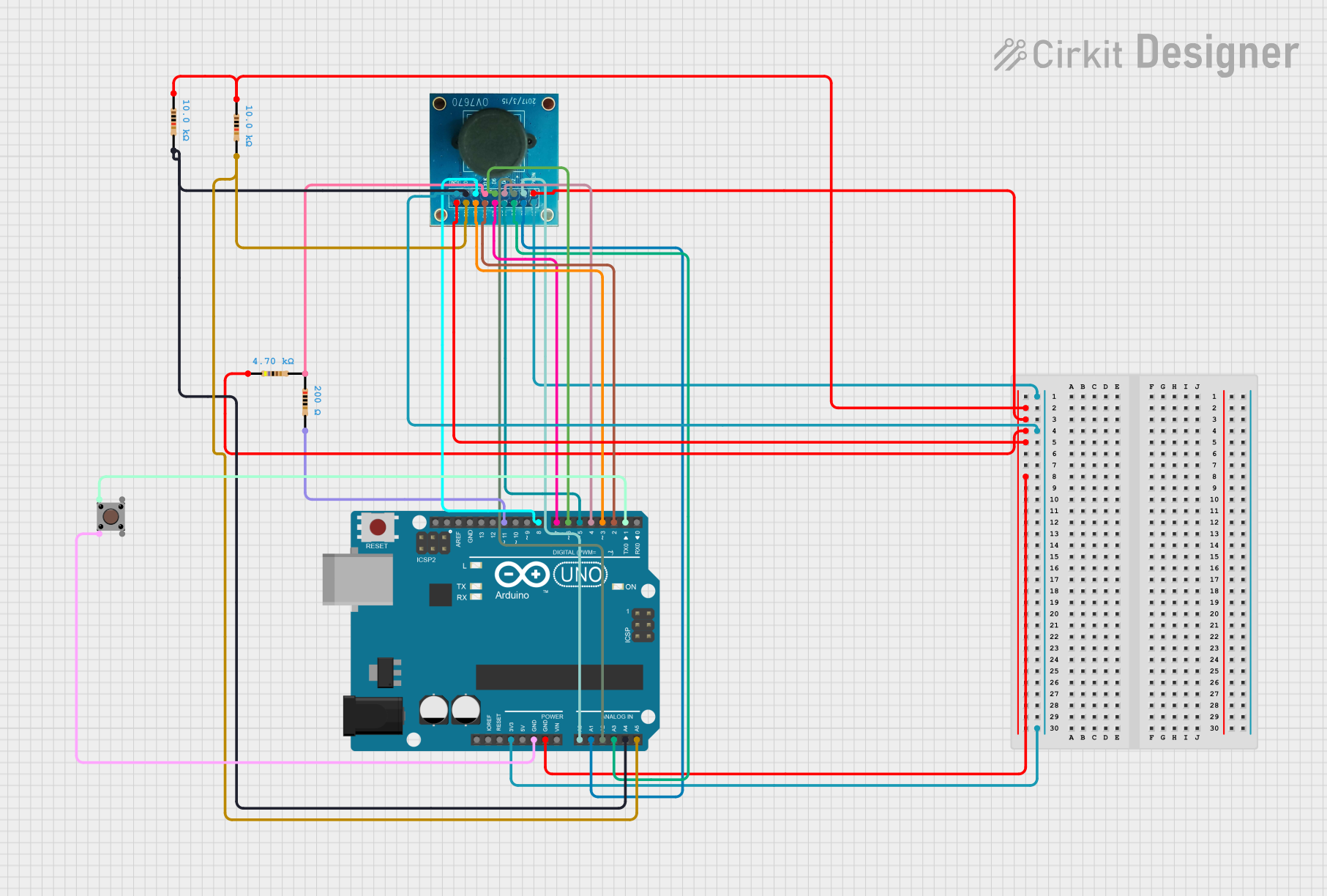
 Open Project in Cirkit Designer
Open Project in Cirkit Designer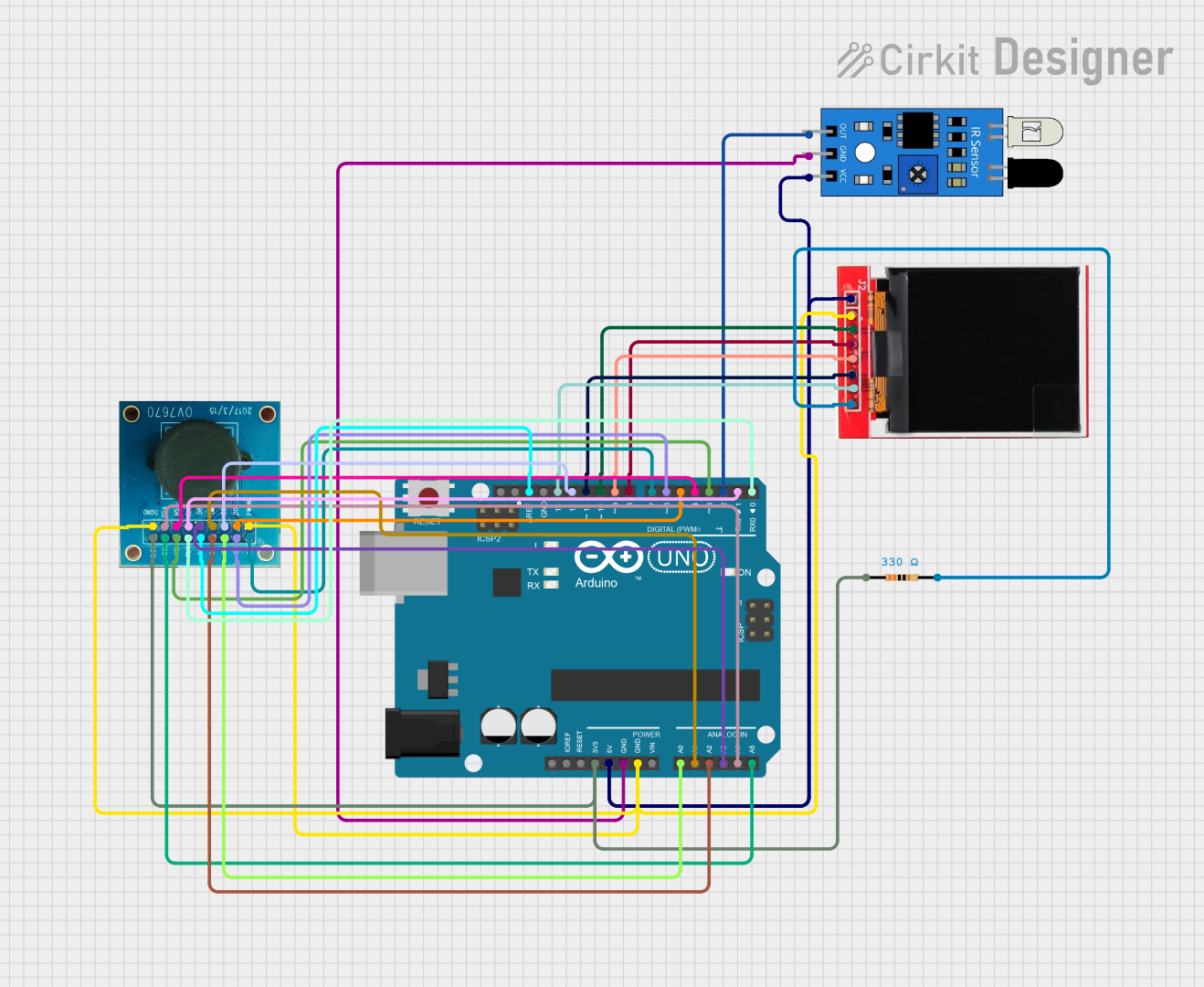
 Open Project in Cirkit Designer
Open Project in Cirkit DesignerExplore Projects Built with 0V7670 Camera Module

 Open Project in Cirkit Designer
Open Project in Cirkit Designer
 Open Project in Cirkit Designer
Open Project in Cirkit Designer
 Open Project in Cirkit Designer
Open Project in Cirkit Designer
 Open Project in Cirkit Designer
Open Project in Cirkit Designer